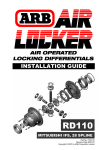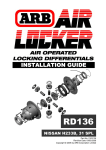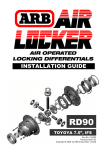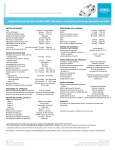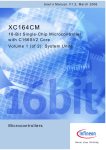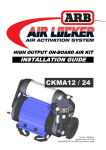Download CKSA12 - Air Compressors Direct
Transcript
COMPACT ON-BOARD AIR KIT INSTALLATION GUIDE CKSA12 Part No. 2102SA12 Revision Date 12/09/05 Copyright © 2005 by ARB Corporation Limited No liability is assumed for damages resulting in the use of the information contained herein. ARB Air Locker Air Operated Locking Differentials, ARB Air Locker Air Activation System and Air Locker are trademarks of ARB Corporation Limited. Other product names used herein are for identification purposes only and may be trademarks of their respective owners. ARB 4x4 ACCESSORIES Corporate Head Office 42-44 Garden St Kilsyth, Victoria AUSTRALIA 3137 Tel: Fax: +61 (3) 9761 6622 +61 (3) 9761 6807 Australian enquiries North and South American enquiries Other international enquiries [email protected] [email protected] [email protected] www.arb.com.au 1 Introduction 1.1 1.2 2 Pre-Installation Preparation Tool-Kit Recommendations 2 2 2 Installing the Compressor 2.1 2.2 2.3 2.4 2.5 3 Installing the solenoid(s) Installing the Pressure Switch Assembling / Installing the Air Filter Using an Air Filter Extension Tube (optional) Mounting the Compressor 3 Connecting the Air System 3.1 3.2 7 Running and Securing the Air Line Connection to the Air Locker Bulkhead Fitting 4 Mounting & Connecting the Electrical System 4.1 4.2 Mounting the Actuator Switch(es) Wiring the Actuator System 9 12 Leak Testing Testing the Air Locker Actuation Electrical Fault Diagnosis Post installation Checklist 12 12 12 12 6 Parts List 6.1 6.2 7 8 9 10 5 Testing & Troubleshooting 5.1 5.2 5.3 5.4 3 3 3 3 4 15 Exploded Assembly Diagram Itemized Parts List 15 16 1 1 Introduction IMPORTANT : To assure the highest level of planning and reliability goes into this installation, please read this guide in its entirety before attempting any modifications to the vehicle. 1.1 Pre-Installation Preparation Although your ARB Air Compressor comes complete with all the step by step instructions you will need to install your new air source, ARB recommends that you have your ARB Air Compressor installed by a trained professional. Many ARB distributors around the world have been fully instructed in Air Compressor installations by ARB, and have gained a wealth of experience and skill from years of performing similar installations. Make sure your Air Compressor kit is the correct model for your application and that it contains all of the parts listed on back cover of this booklet. Also be sure you have appropriately equipped yourself with all the necessary tools, parts, and materials to complete this installation (see section 1.2 Tool-Kit Recommendations) and minimize vehicle down time. Please refer to your ARB Air Locker Operating & Service Manual for information on operating, servicing, driving technique, or trouble shooting your ARB Air Locker(s). HINT : Place a mark inside each of the symbols as you complete each step. It is very important NOT to miss any of the steps! 1.2 Tool-Kit Recommendations Below is a list of tools and supplies you may need to complete this installation. 1.2.1 Tools Standard automotive sizes (metric and/or imperial) of sockets, wrenches, Alan keys, and drills. A razor knife to cut the nylon tubing. A leak test gauge (i.e., ARB# ALTG01). A multimeter. A soldering iron. 1.2.2 Supplies Thread lubricant/sealant compound for pressure fittings (e.g., LOCTITE #567 Teflon paste or plumbing supply Teflon tape) A soap and water mixture to test for air leaks. Electrical tape. Solder and/or automotive crimp fittings. 2 2 Installing the Compressor 2.1 Installing the Solenoid(s) IMPORTANT : This step applies to the 12V solenoid that is packed with each ARB Air Locker differential. If the compressor is to be used for an alternate purpose then skip this step and plug or terminate the ports as required by the application. Remove one of the 1/8” BSPT plugs from its port in the compressor manifold using a 5mm hex key. Apply Teflon paste/tape to one end of the nipple (1/8” X 1/8” BSPT), insert into the port and tighten. Apply Teflon paste/tape to the free end of the nipple. Assemble the inlet port side of the solenoid (marked as port ‘1’) onto the nipple and tighten. The solenoid should be rotated into a position that does not obstruct any other ports on the compressor manifold. NOTE : The solenoid exhausts compressed air through the center of the black retaining cap when the Air Locker is disengaged. Make sure this orifice cannot be obstructed. Apply Teflon paste/tape to the threads of the 5mm push-in fitting and assemble it into the solenoid outlet port (stamped “2”) and tighten using a wrench/spanner. NOTE : Do not tighten fittings any more than hand tight. If two Air Locker units are being controlled with this air source then repeat this step for the second solenoid. 2.2 Installing the Pressure Switch Remove the rubber dust plug from the middle port in the compressor manifold and discard. Apply Teflon paste/tape to the threads of the pressure switch and assemble it into the port and tighten with a wrench/spanner. NOTE : Do not tighten any more than hand tight. 2.3 Assembling / Installing the Air Filter Insert the foam filter cartridge into the air filter base. Assemble the filter cover by aligning the 3 notches between the cover and the base and applying pressure until it snaps into place. Screw the air filter assembly into the threaded hole in the front of the compressor. NOTE : If an intake extension tube is to be used then the extension tube will be screwed into the front of the compressor and the air filter will be screwed into the extension tube (See section 2.4). 2.4 Using an Air Filter Extension Tube (optional) The air filter of the CKSA12 was designed so that it could be relocated to a more suitable location (if required) using an extension tube. IMPORTANT : The length and inside diameter of the extension tube can restrict the intake flow and negatively affect the performance of the compressor. In severe cases this could result in overheating and/or damage to compressor components. Use the following chart to make sure that your extension tube will not restrict the intake flow. 3 2 Installing the Compressor Measure the intended length of the extension tube. Maximum Length of Tube Minimum Inside Diameter of Tube 300mm [11.8”] = 8mm [0.32”] 800mm [31.5”] = 10mm [0.39”] 1770mm [69.7”] = 12mm [0.47”] 3430mm [135.0”] = 14mm [0.55”] 6130mm [241.3”] = 16mm [0.63”] Consult the chart above for the recommended minimum inside diameter of the tube. NOTE : ARB does not recommend connecting your compressor intake to the air supply in a ‘snorkel’ or other part of the air ducting for engine aspiration. However, if an extension tube is used to relocate the compressor intake to your engine intake supply then it must be understood that the negative pressure (vacuum) created by the engine when it is running will adversely affect compressor performance. DO NOT RUN THE COMPRESSOR FOR APPLICATIONS OTHER THAN ENGAGING AN AIR LOCKER WHEN THE ENGINE IS RUNNING. NOTE : Do not run the tube through areas where it will be exposed to elevated temperatures while the compressor is running as this will pre-heat the air intake and reduce compressor performance. Assemble an extension tube with a ¼” NPT male fitting at one end and a ¼” NPT female end at the other. Install the tube inline with the air filter. Secure loose sections of the tube and the air filter. 2.5 Mounting the Compressor Loosen the two motor mount screws so that the compressor can be freely pivoted in its mount while establishing a good mount position. MOTOR MOUNT SCREWS Figure 1. 4 2 Installing the Compressor Identify a position on the vehicle or inside the cabin where the compressor can be safely and conveniently mounted. NOTE : The ideal position of the compressor should give consideration to all of the following points: 1. Keep away from sources of heat (e.g., too close to exhaust system components or directly behind the radiator, etc.). 2. The position should be safe from damage or abrasion caused by sand or gravel from the road surface. 3. Avoid any extended exposure to direct sunlight. 4. Keep away from excessive moisture (e.g., directly exposed to road spray or rain runoff). 5. Mounting location should be above the highest possible waterline to avoid submerging during water crossings. 6. The position must allow free flow of dry, cool air to the air filter assembly (unless an intake extension tube is to be used, in which case it is the filter assembly and the extension tube which must be located accordingly). 7. The position should allow access to the air filter assembly for filter disassembly and cleaning (unless an intake extension tube is to be used). 8. If an intake extension tube is to be used then consideration should be given to the intake position so that the distance (length of tube) between the compressor mounting location and the actual air intake point can be kept to a minimum. 9. The position must allow the compressor motor mounting bracket to firmly secure the compressor using all 4 bolts. 10. The position must allow access to the opposite side of the mounting location so that the backing plate and locking nuts may be installed. 11. Parts of the compressor may get hot while running for long periods of time, and therefore the compressor should be located away from where it could be touched by children or pets. 12. The position should permit a short, protected and accessible route for the wiring loom to follow. 13. The compressor should not be mounted in a position where the running sound might be considered startling or irritating for vehicle occupants. 14. The compressor should not be mounted in close proximity to devices that are sensitive to the electromagnetic fields of DC motors (e.g., compasses, radio/GPS antennas, engine management sensors, etc.). 15. Where possible, the compressor should be mounted close to the location of the Air Locker equipped axle in a single Air Locker system, or halfway between both axles in a dual Air Locker system. 16. Never mount the compressor in a position where it would be considered unsprung mass (e.g., mounted directly to the axle or the engine block). 5 2 Installing the Compressor Using the compressor backing plate as a template, or referring to Fig.2. for exact sizes, drill four mounting holes at a diameter of 6.5mm [0.26”]. NOTE : Try to drill holes accurately. Holes should never be drilled open to more than 8mm [0.31”] in size to compensate for misalignment. Figure 2. Hold compressor in place and assemble bolts through the rubber vibration isolators in the compressor mount and into the newly drilled holes. Figure 3. Assemble the backing plate onto the protruding bolts from the opposite side. Install the locking nuts with the nylon locking flange facing away from the backing plate (as shown in Fig 3.). Tighten to a torque of approximately 3.5 Nm [2.5ft-lb]. Rotate the compressor motor in the mount to its most desirable position and tighten the two mount screws to a torque of approximately 2 Nm [1.5 ft-lb]. 6 3 Connecting the Air System 3.1 Running and Securing the Air Line IMPORTANT : The path taken by the air line from your compressor to your Air Locker is unique to your vehicle and the desired position of your compressor. Plan ahead carefully when running the air line and always follow these guidelines: NOTE : The flexible 5mm air line described here is supplied with your Air Locker kit and NOT with your ARB compressor kit. If you require air line to complete your installation then contact your ARB Air Locker distributor. Account for axle travel when running the line from the axle to a fixed point on the vehicle. Leave enough slack in the air line to allow for maximum suspension travel in both directions. (Not necessary on IFS installations) Avoid leaving large lengths of air line hanging underneath the vehicle where they may get tangled on rocks, sticks, etc. HINT : Cable tying the air line to one of your flexible brake lines will account for axle travel and should help keep your line from getting snagged. Run the air line all the way from the compressor to the differential before trimming either end of the line to length. This will save complications that may arise if the air line has to be removed. Make sure the line does not contact sharp edges or abrasive surfaces that may damage the air line over time. Do not run the air line around tight bends which may kink the air line and restrict or block the air flow. Keep the air line well away from your vehicle’s exhaust components. Air lines will melt if subjected to extreme heat. Do not run more air line than necessary. Excess line volume created when coiling the left over hose, using unusually large diameter hose, etc., will increase drain on the compressor resulting in the compressor running more often than needed. Support the air line by tying it back with cable ties wherever possible. At the solenoid end of the air line, always trim the line to length with a sharp knife to avoid distorting the tube where it plugs into the push-in fitting. To attach the air line to the push-in fitting of the solenoid; insert the line firmly into the fitting, pull outward on the flange of the fitting while holding the line as far into the fitting as possible, and then gently pull outward on the air line to clamp the line in place. NOTE : To remove the air line from the push-in fitting; while holding the flange of the fitting out, push the air line into the fitting as far as possible, then press the flange inward, then pull the air line free of the fitting. 7 3 Connecting the Air System 3.2 Connection to the Air Locker Bulkhead Fitting In the case of an IFS axle assembly or in the case that the axle assembly has been completely removed from the vehicle, the assembly will have to be remounted in order to position the bulkhead fitting in its correct location for air line access. Trim the air line to length using a sharp knife. Insert the support spring over the end of the air line - small end first. (Fig.4.) Insert the outer compression nut over the air line. Insert the 5mm [0.197”] ferrule over the end of the air line. Leave approx. 5mm of tubing between the ferrule and the end of the tube. Figure 4. Insert the support tube all the way into the end of the air line. HINT : If the support tube is too difficult to insert, place the end of the air line into a cup of boiled water to soften the tubing. Insert the tube end all the way into the center compression nut of the bulkhead fitting. Screw on the outer compression nut, while supporting the center compression nut from turning, and tighten. The ferrule and support tube are now permanently attached. Assemble the support spring over the outside of the outer compression nut. Secure any loose sections of tube with a cable tie. 8 4 Mounting & Connecting the Electrical System 4.1 Mounting the Actuator Switch(es) ARB compressor and Air Locker actuator switch(es) can be easily panel mounted inside the vehicle in a 21mm x 36.5mm [0.83” x 1.44”] rectangular cutout. NOTE : Air Locker actuator switches are packed with each Air Locker differential. HINT : Only attach the cover plate to the face of the switch once the switch has been mounted and wired correctly as the cover plates are designed to be difficult to remove. For reasons of safety and for ease of operation, the Air Locker actuator switch(es) should be mounted in a location picked to best suit the operator. Make sure you have taken the following points into consideration: Switch(es) MUST be mounted and should never be allowed to simply dangle from the wiring loom during vehicle use. Switch(es) should be within easy reach of the driver. Ideally, any Air Locker switch should be able to be operated without physical effort or distraction to the driver. (compressor switch location is not critical) Switch(es) should be mounted within the line of sight of the driver so that switch position (‘ON’ or ‘OFF’) can be visually determined by the rocker position and the illumination state. The position of the switch(es) should best eliminate any possibility of accidental operation by the driver or one of the passengers. Switch cutout position(s) must be located in an area with a minimum of 50mm [2”] of clearance behind the face of the cutout. Switch(es) should not be mounted where they will be exposed to water (e.g., in the lower section of an inner door panel). ARB recommends that you apply the Air Locker Warning Sticker (ARB part # 210101) within close visual proximity of the switch location. NOTE : If no adequate position can be found on existing dashboard panels, a surface mounted bracket (Fig. 5.) may be purchased from your ARB Air Locker distributor to suit 1, 2, or 3 switches. Figure 5. 9 4 Mounting & Connecting the Electrical System 4.2 Wiring the Actuator System When wiring an ARB compressor switch, Air Locker pressure switch, Air Locker actuator switch(es) and Air Locker solenoid(s) to an ARB Air Compressor, all connections can easily be set up using only the supplied wiring loom (ARB #180408 - Fig.7.) Consulting the wiring diagram (Fig.7.) for wire colors, and the switch terminal illustration (Fig.6.), plug each of the female spade terminals onto their appropriate switch terminal. IMPORTANT : As a safety precaution, the ‘SWITCH 2’ position in the wiring loom will not activate unless ‘SWITCH 1’ is already activated. Therefore, if both front and rear Air Lockers are installed then the rear MUST be controlled by ‘SWITCH 1’, and the front by ’SWITCH 2’. This serves to reduce the risk of accidental engagement of the front Air Locker. If only one Air Locker is installed then it should be wired using the terminals for ‘SWITCH 1’, regardless of whether the Air Locker is mounted in the front or rear axle. Using a multimeter or an automotive test light, locate an accessory outlet or cigarette lighter port in the vehicle. NOTE : The desired outlet should supply positive 12 volts DC, be fused at 15 amps, and be live only when the vehicle ignition key is in either the ‘ACC’ position or in the ‘ON’ position. Using a soldering iron or automotive quality crimp connectors, splice the red/yellow wire (i.e., the red wire with a yellow stripe) onto the positive (+) wire of the accessory outlet pair. Insulate the junction area well with electrical tape. Using a multimeter or an automotive test light, locate an active dash light supply wire. NOTE : The desired wire should supply 12 volts DC (less if dimmed) and react to the illumination level of the instrumentation / dash light dimmer. Using a soldering iron or automotive quality crimp connectors, splice the blue/white wire (i.e., the blue wire with a white stripe) onto the active illumination supply wire. Insulate the junction area well with electrical tape. Assemble the 4 male spade connectors on the loom into the supplied plastic connector housing so that each wire color matches up with the same color when the 2 halves of the housing are plugged together. NOTE : This connection has been supplied disassembled to assist in the routing of the compressor loom through a 10mm drilled hole (e.g., through the firewall) if necessary. Run the remainder of the loom to the compressor mounting position. Plug the 2 female spade terminals onto any of the 2 compressor pressure switch terminals. Plug the compressor motor connectors together. Plug the female solenoid connector with a yellow wire into the solenoid controlling the rear Air Locker (or the front Air Locker if only a front Air Locker is installed). Plug the female solenoid connector with a green wire into the solenoid controlling the front Air Locker (if 2 Air Lockers are fitted). Ground the black negative wire by bolting the 6mm [1/4”] eye terminal where it can make direct contact with the body of the vehicle. NOTE : In vehicles that do not employ a body ground such as aluminum bodied vehicles, remove the eye terminal and splice this wire directly to an existing negative terminal capable of carrying 15 amps. 10 4 Mounting & Connecting the Electrical System Figure 6. SWITCH TERMINALS Figure 7. ARB AIR COMPRESSOR WIRING LOOM (CKSA12) 11 5 Testing & Troubleshooting 5.1 Leak Testing With the vehicle parked and the engine off, turn the compressor on and wait until the air system is fully charged. NOTE : With the Air Locker(s) disengaged, the compressor should not have to recharge over time. Intermittent recharging without Air Locker use usually indicates a leak at the solenoid or pressure switch fittings. Actuate the Air Locker(s). The compressor should not come on again for a period of at least 15min. Air system recharging within that time period would indicate that a leak is present in the system. If a leak is found to be present, spray a soap and water mixture onto all air fittings in the system while the compressor is fully charged. Bubbles should appear at any leak points. Check that leaky fittings have been adequately tightened. If leaking persists then disassemble fittings, clean threads, and reapply thread sealant. 5.2 Testing the Air Locker Actuation To test that your air system, electrical system, and your Air Locker differential is functioning correctly: Support the vehicle such that the wheels are free to rotate (e.g., on axle stands, a chassis hoist, etc.) Leave the parking brake off, the transmission in neutral, and the Air Locker switch ‘OFF’. Turn the ignition to the ‘ON’ position (leaving the motor off). The large symbol on the Air Locker switch cover should not be illuminated. Turn the compressor on to charge the air supply to maximum pressure. While supporting the drive shaft flange, rotate one wheel by hand. The wheel should rotate freely and the opposite wheel should be turning in the opposite direction without any resistance or mechanical noise from within the differential. Turn the Air Locker switch to the ‘ON’ position. The symbol on the switch cover should light up. Rotate the same wheel again and check that both wheel rotate together. Turn the switch off again. Rotate the same wheel again. The wheels should again rotate in opposite directions. 12 5 Testing & Troubleshooting 5.3 Electrical Fault Diagnosis The following describes an effective procedure for tracing an electrical fault in an ARB CKSA12 compressor which has been wired using a genuine ARB wiring loom. All steps must be performed in the order listed here for an accurate assessment. NOTE : Before attempting to troubleshoot a malfunctioning compressor, always make sure that the compressor manifold has been de-pressurized, all connections have been made according to the wiring diagram (Fig. 7), the vehicle’s ignition is in the accessory power position, and that the isolating switch has been turned ‘ON’. STEP # 1 Using a multimeter, check the voltage at the battery terminals to make sure the battery is working and is fully charged. Did the battery measure at least 11.5 volts? YES Proceed to STEP 2. NO Insufficient battery voltage. Recharge or replace the battery. 2 Disconnect the compressor motor from the wiring loom at the connector plug. Run a wire directly from the negative terminal of the battery to the BLACK wire of the compressor motor. Momentarily connect a wire from the positive battery terminal to the RED wire of the compressor motor. Did the compressor activate when the wires were connected? YES Remove the extra wires and reconnect the compressor motor plug. Proceed to STEP 3. NO Internal compressor problem. Contact ARB for assistance. 3 Using a multimeter, check for battery voltage (approx. 12V) at the RED/YELLOW wire connected to terminal #2 of the compressor isolation switch. (i.e., the wire leading from the vehicle’s accessory power.) Was battery voltage detected? YES Proceed to STEP 4. NO Wire has not been connected correctly or accessory power has not been turned on. Attach RED/YELLOW wire to live accessory power. 4 Using a multimeter, check for battery voltage (approx. 12V) at the SOLID RED wire connected to terminal #3 of the compressor isolation switch. (while still connected) Was battery voltage detected? YES Proceed to STEP 5. NO Switch fault or switch not turned ‘ON’. Replace switch or toggle switch to ‘ON’ position. 5 Using a multimeter, check for battery voltage (approx. 12V) at the SOLID RED wire connected to the pressure switch installed into the compressor manifold. Was battery voltage detected? YES Proceed to STEP 6. NO Wiring fault between the isolating switch and the pressure switch. Replace wiring. 6 Using a multimeter, check for battery voltage (approx. 12V) at the RED/WHITE wire connected to the pressure switch installed into the compressor manifold. (while still connected) Was battery voltage detected? YES Proceed to STEP 7. NO Pressure switch fault or compressor not de-pressurized. Replace switch or drain pressure. 7 Disconnect the compressor motor from the wiring loom at the connector plug. Using a multimeter, check for battery voltage (approx. 12V) at the RED/WHITE wire on the loom side of the plug. Was battery voltage detected? YES Proceed to STEP 8. NO Wiring fault between the pressure switch and the compressor motor connector. Replace wiring. 8 Using a multimeter, check the continuity (resistance) between the SOLID BLACK wire on the loom side of the plug (not on the compressor side) and the negative terminal of the battery. Did the resistance measure less than 1 Ohm? YES Intermittent fault or internal compressor problem. Contact ARB. NO Wiring fault in the ground wire between the battery and the compressor motor. Replace wiring. 13 5 Testing & Troubleshooting 5.4 Post-Installation Check List Now that the compressor installation has been completed, ARB recommends that you take the time to complete the following check list just to insure that you haven’t missed any of the vital steps. The air system has been leak tested. The air filter position will not be exposed to moisture, dust or dirt. All air lines and wiring have been securely cable tied to resist snagging. Switch(es) have been securely mounted within operator reach, yet well away from danger of accidental engagement. Switch(es) function properly and illuminate to indicate activation. INSTALLATION PERFORMED BY: ______________________________ DATE OF INSTALLATION: ______________________________ ARB SERIAL No: ______________________________ 14 6 Parts List 6.1 Exploded Assembly Diagram (See itemized parts list overleaf) Figure 8. 15 6 Parts List 6.2 Itemized Parts List (See exploded diagram figure 8.) AIR COMPRESSOR MODEL No. : ITEM # QTY 01 02 03 04 05 06 07 08 09 * * * * 4 1 4 1-2 1 2 1 1 1 1 1 1 1 * CKSA12 DESCRIPTION MOUNTING BOLT (M6 x 25mm) BACKING PLATE MOUNTING NUT (M6 locking) PNEUMATIC SOLENOID PRESSURE SWITCH PLUGS COMPRESSOR ASSEMBLY FILTER CARTRIDGE AIR FILTER HOUSING WIRING LOOM ACTUATOR SWITCH SWITCH COVER (COMPRESSOR ISOLATION) INSTALLATION GUIDE Not illustrated in exploded view. 16 PART # 200405 290603 6151223 NOT SUPPLIED CO35 170802 CKS01 300502 300501 180408 180209 180212 2102SA12























